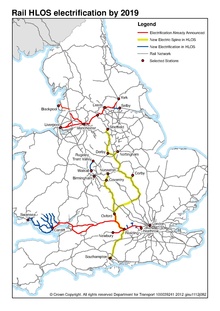
The "Electric Spine" was the name for part of a, now largely cancelled,[1] rolling programme of railway electrification projects[2] in England initially estimated to cost £800 million,[3][4] but later thought to cost close to £3 billion.[1] The aim was to form 25 kV AC overhead-wire electrified links northward from the Port of Southampton to major cities in northern and central England and dry port container terminals in the Midlands. The government wanted efficient electric-hauled freight trains to compete with road haulage.
In 2012, the spine was set to be completed within Network Rail's Control Period 5 (CP5, 2014–2019).[5] This was not the case, because various works were delayed,[6] suspended for several months,[7] moved into Control Period 6 (CP6, starting in 2019),[8][9] and then scrapped altogether[1] (despite various preliminary work, like bridge replacement, having been conducted).[10]
Other works associated with the project included gauge clearance for large shipping containers and electrified connections to adjacent electrified routes, depots and freight facilities.[5]
The north–south axis of the link leads to the spine name.
- ^ a b c "Rail electrification plans scrapped by government". BBC News. 20 July 2017. Retrieved 22 July 2017.
- ^ Cite error: The named reference
networkrail.co.ukwas invoked but never defined (see the help page). - ^ Cite error: The named reference
nr-cp5-delivery-plan-draftwas invoked but never defined (see the help page). - ^ "Investing in rail, investing in jobs and growth". Gov.uk (Press release). 16 July 2012. Retrieved 2 April 2014.
- ^ a b Cite error: The named reference
gov.ukwas invoked but never defined (see the help page). - ^ Cite error: The named reference
railtechnologymagazine.comwas invoked but never defined (see the help page). - ^ Cite error: The named reference
pausedwas invoked but never defined (see the help page). - ^ "Hendy review - Network Rail". www.networkrail.co.uk. Retrieved 13 November 2016.
- ^ Hendy, Peter (January 2016). "Report from Sir Peter Hendy to the Secretary of State for Transport on the replanning of Network Rail's Investment Programme - Enhancements Delivery Plan Update" (PDF). Network Rail. Archived from the original (PDF) on 4 February 2016.
- ^ Cite error: The named reference
:2was invoked but never defined (see the help page).